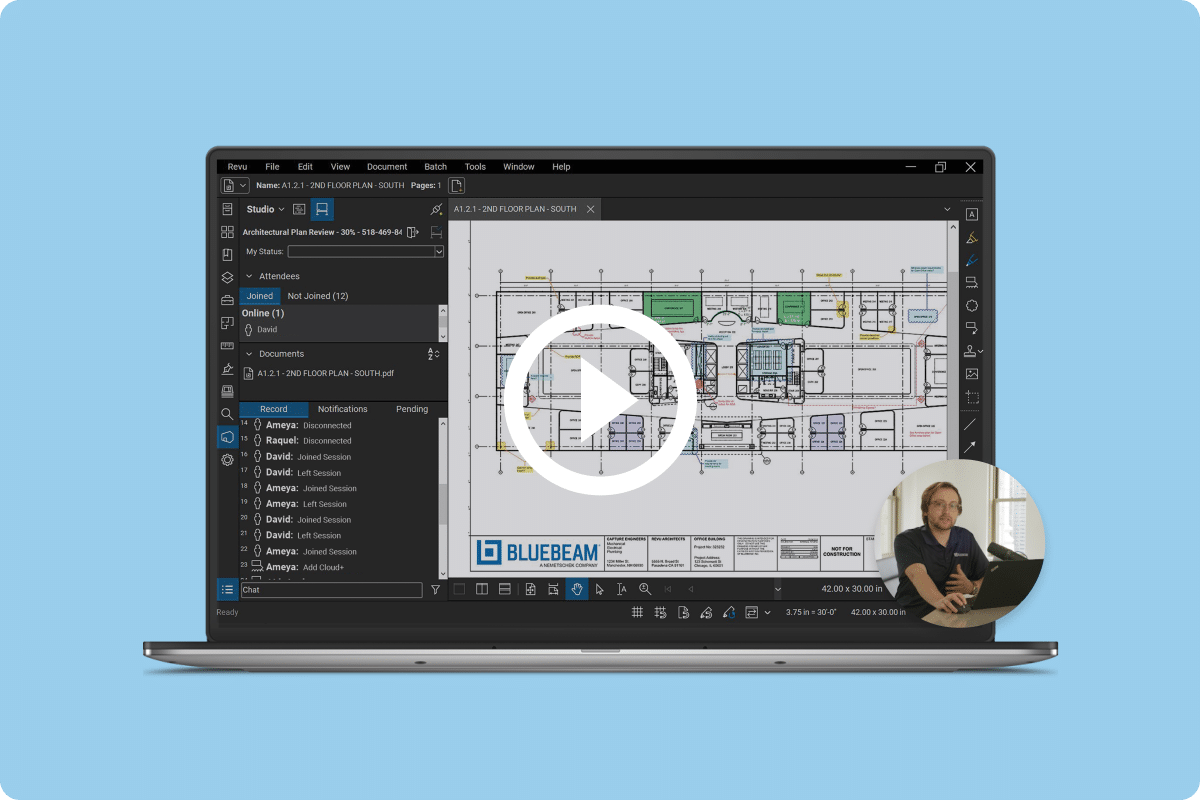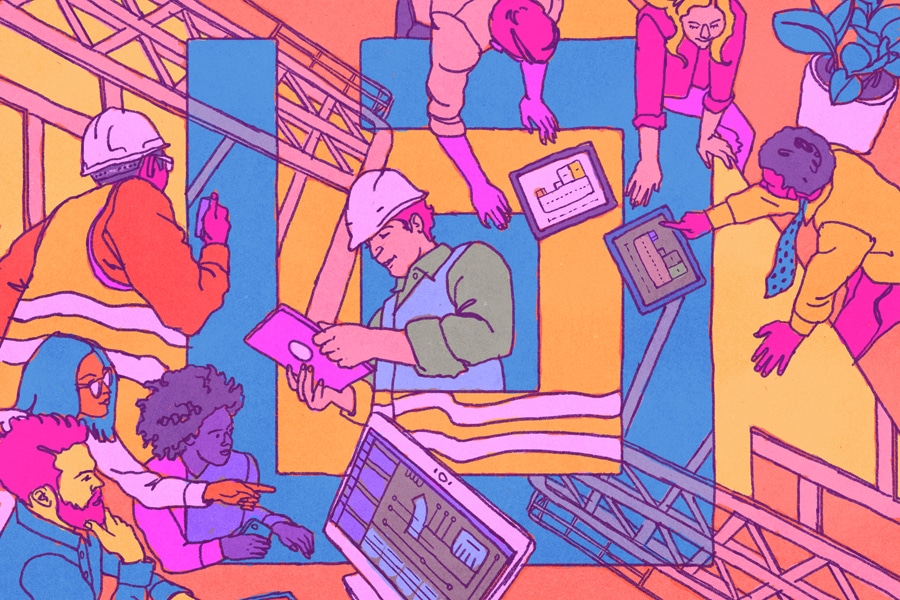In 2022, Bluebeam celebrated its 20th anniversary. As one of the company’s founding team members, I wanted to use the occasion to reflect on this incredible journey.
It’s profound to experience growing a company from inception, with a handful of people passionate about software, to close to some 400 employees all across the globe today. The memories and milestones along the way have made for an unforgettable journey.
I wanted to briefly share some of the lessons from the early days that have formed the backbone of what has made Bluebeam such a great company, serving millions of customers in the architecture, engineering and construction (AEC) industry across the globe.
Lesson #1: Power of Teaming
Like many technology companies, Bluebeam was founded in a garage/warehouse in 2002, when the AEC industry was in a much different place. In fact, Bluebeam started in a completely different industry, manufacturing and aerospace design. Eventually, we realized there was a much bigger and broader need in the AEC industry.
As a small company, everyone must be involved in all aspects of the business, doing whatever it takes to complete software releases on time, making a sale and doing whatever else is needed to keep the doors open and bills paid for another month. In these times bonds are formed and the DNA of a company is made.
We all worked together, regardless of title, to achieve the company’s goals. Those moments of making the big decisions as a company raised us to the next level. We spent more time together in those early years than we did with our families. I sometimes even joke that Bluebeam was my first child.
I think of the time when, after going to tradeshows over and over with the same small pop-up display, we looked like all the other vendors with their own tiny displays. So we thought, ‘We’re going to go big,’ so we made the commitment to get a 40-foot by 40-foot custom-designed booth. This way we could be out there with the big boys.
It’s amazing in hindsight that this seemingly minor marketing decision drove so much business for the company.
This “going big” mentality in our marketing forced us to live up to the hype with our software. So, at the AIA Miami show in 2010, we showed up with an announcement about something new and big: Bluebeam Studio.
Studio transformed us as a company. It was our first entry into cloud computing, and it enabled a whole new form of collaboration in the industry. It also shaped Bluebeam for many years to come; to this day, Studio remains an essential part of construction projects worldwide.
Another highlight from those days came with every new major release as the engineers would demo the features. I remember these as electric, unifying moments. The meetings were charged with energy; we were finally unveiling to the company the latest and greatest of our products. These events generated great excitement, seeing what shortly would be in the hands of our customers.
These examples highlight the close collaboration, partnership, excitement and support for each other in the early era of Bluebeam—coming together to support functions. It didn’t matter who was doing what; we were all there to support one another.
Lesson #2: Embrace “Scrappiness”
Early on, especially with the minimal financial resources we had, scrappiness—in short, doing more with less—was a key characteristic in every aspect of the business. When a company grows, however, you can’t stay scrappy in the same way. When you are small, you never have enough resources; when you are large, resources are dedicated elsewhere with competing interests.
At all phases of the company, doing whatever it takes to get the job done requires working around hurdles and always being willing to overcome the persistent challenges that will inevitably arise.
Lesson #3: Stay Close to the Customer
Knowing the customer and the market, and building the intuition and a close connection with users, are all vital ingredients that help a technology company like Bluebeam, no matter what stage of growth you’re in. Not only is it important to listen to the customer, but in construction you have to actually go to the jobsite. Walking in customers’ boots and observing how they work is essential to truly being able to address their needs through technology. Doing this influenced the uncountable small and large decisions that were made as we continued to improve our software.
I like to think that this intensive customer-centric approach is part of the reason Bluebeam continued to grow during rough periods for the economy. During the Great Recession of 2008-09, when the construction industry needed to enhance its efficiency to survive, Bluebeam was there with a solution. The industry needed to re-evaluate how project documentation could get done so projects were completed faster.
Enhancing Revu with real-time collaboration in Studio played a big role in solving this industry challenge, minimizing paper, speeding up project reviews and widening the opportunity to bring teams together more efficiently. By having a deep understanding of customers and the industry’s needs at this perilous time, Bluebeam was able to build solutions for a major industry problem.
Bluebeam has had such a productive relationship with the industry because, in many ways, our customers are an extension of our team, working together to advance the industry.
Lesson #4: The road is never straight; expect the road bumps; enjoy the ride
The hurdles, however difficult they may feel in the moment, are also opportunities. We learned early to adjust, adapt and learn; to be agile in our thinking in the business. This mindset has been vital to our continued growth. Having a direction is important, to be sure, but having the confidence to adapt and adjust in the face of challenges is just as important.
It can be somewhat scary when the path you originally planned changes out from under you, either because of market conditions, learning more about customers or industry changes. Still, having the confidence to adapt and move forward to me is what separates the companies that survive from the ones that don’t.
Bluebeam was forged in tough economic times, right after the bursting of the initial internet bubble. We grew again during the Great Recession nearly a decade later. And, more recently, as the COVID-19 pandemic sent the industry into remote work, our cloud-based ecosystem was there in what was certainly a fast and difficult transition.
It’s in these times that our customers were looking for ways to streamline their operations to evolve and survive. We at Bluebeam wanted to help in those times, and we continue to grow together as the industry progresses.
As I reflect on the opportunities and challenges over the past two decades, I’m encouraged by the ever-expanding opportunity within our industry. Construction technology wasn’t really a thing in 2002, and it’s amazing to see how vital and important a focus this area has been as a cornerstone for society.
Finally, it’s been incredibly rewarding to see all the great people who have been a part of shaping Bluebeam. So, too, I think Bluebeam has left a mark on our current and past employees, hopefully instilling in them a part of the specialness that is Bluebeam.
It has been gratifying to have influenced these people and to see them paying it forward by carrying elements of the Bluebeam DNA with them as they advance in their careers both here and elsewhere, inside and outside the AEC industry.
Here’s to the next 20 years!





